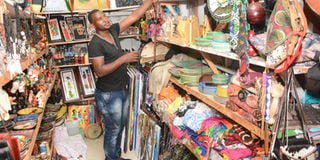Export crafts for cash

A man sells crafts in Kampala. Exporting crafts is one sure way to earn in foreign currency.
Photo by GODFFREY LUGAJJU
What you need to know:
Uganda is among those countries that are blessed with valuable artisanal crafts. Why not earn some more from exporting them? Dorothy Nakaweesi gives you a step-by step guide on staring a crafts export business.
Let’s talk big money. I mean earning in dollars or euros. I trust you are now visualizing the millions you will be getting after converting your foreign notes.
Now that you’re visualizing the money, exporting crafts is one sure way to earn in foreign currency. Yes! Exporting products to the United States of America, European Union, or China.
At the domestic and cultural level, Ugandan crafts can be identified under the following categories: gourd vessels and wood vessels for food and drinks; pottery; pipes; basketry; stools; miscellaneous household objects; clothing and adornments; skins and bark cloth; tails and aprons; belts and girdles.
Most Ugandans who have tried their hands at making these admirable crafts are earning some good money in foreign currency through exporting. You too can.
Ms Susan Muhwezi, the senior presidential advisor on African Growth and Opportunity Act (Agoa) says the demand for crafts is so huge starting from US’s Agoa. But there are markets such as China, Canadian, and UK.
“Agoa can take as much as Uganda can produce because it’s a huge market. We are not even able to supply a quarter of what the US market wants,” Ms Muhwezi shares.
So, what does it take to start?
To do this business credibly, you need to win trust from your buyers by registering your company with Uganda Registration Services Bureau (URSB) and tax registration to acquire a Tax Identification Number (TIN).
When exporting crafts, you will not be required to have an export licence or permit. However, you are advised to register with business support institutions such as Uganda Export Promotions Board (UEPB).
“This will help you gain access to available support services including capacity building, market information and business linkage,” Mr John Lwere, Uganda Export Promotions Board trade and information executive, shares.
Registration with UEPB is free. However, other entities may charge fees depending on the services they will be offering.
So then, if the potential exporter is targeting the European Union (EU), then registration into the EU Registered Export System (REX) is compulsory.
This is a new system used by the EU replacing the GSP (Generalized System of Preferences) and EU certificates of origin that have been used in the past to declare origin of products.
Mr Lwere says if the potential exporter is targeting other preferential markets other than the EU, then the exporter is required to register onto the Single Window System to access all preferential certificates of origin.
Money
After putting your documents in order, you can start doing business. Your operating capital will always depend on the number of orders you have and clients.
“Ideally one would require between Shs3million and Shs5million to start. This will include clearing your exporting documents. But this goes back to your market/buyer,” Ms Brenda Opus, UEPB marketing executive, said.
Exporting steps
If the crafts you are going to export are made out of plant raw materials, you are then required to fumigate them.
“An internationally recognised fumigation certificate will be required as evidence of fumigation,” Lwere shares.
The ministry of agriculture, animal industry and fisheries has a list of the certified fumigators. The fumigator will charge in accordance to the work to be done but the fees are negotiable.
The next step is to generate an invoice/packing list with details of the products being exported.
“The exporter is required to get a Certificate of Origin, for preferential certificates of origin, or visit Uganda National Chamber of Commerce and Industry for a General Certificate of Origin,” Lwere advised.
In some places, preferential certificates of origin are free. However, when you access the Certificate of Origin from UNCCI, it will cost you about Shs20,000.
Lwere shares: “The requirements mentioned are required to export crafts as per the regulations of Uganda. However, the buyer may require the exporter acquire/provide additional documentation.”
You are then advised to consult the buyer and seek guidance on additional documentation required to enter the market.
Exporter
Ms Victoria Byoma Ssenkubuge, a Comesa leather expert with vast knowledge in making crafts out of banana fibres, palm leaves with a blend of leather, sells them locally in addition to exporting.
She has some advice for would-de exporters.
“You have to develop capacity to sustain the exports market,” Ms Ssenkubuge says.
Ms Byoma makes ladies hand bags out of banana fibre, centre pieces, ornaments, decoration items, table mats, mats, and purses among other products.
“This is the kind of business you can do in your free time. The beauty is the raw materials (banana fibres) are easily accessible in our backyards, villages and markets,” she shares.
You can design crafts into different products which mostly have a big market outside Uganda.
Advice
Byoma shares that many people who get these deals unfortunately supply once, twice and fail on the third order.
So this is an opportunity for you to exploit by first, identifying your suppliers countrywide. To succeed in this area, you should be patient according to Ms Byoma.
“One has to work out backwards right from the suppliers of the raw materials if you are to make the crafts yourself or contract those who make to supply,” she shares.
It is wise to have a regular production schedule; your products should be of standard depending on the specifications of your buyers. This will require you to have a big work force and to always be practical with your workers.
If possible, you can network and create other production centres that can do crafts that are similar to what you produce. Same standards this will help you to stock.
Document your products. This involves explaining how the crafts are made and how you package them.
Seek knowledge with Uganda Export Promotions Board for further information and get training modules to acquire knowledge on exports markets.




